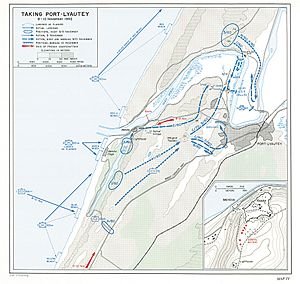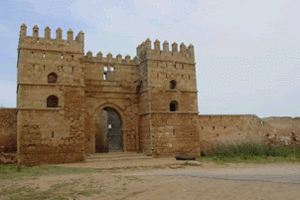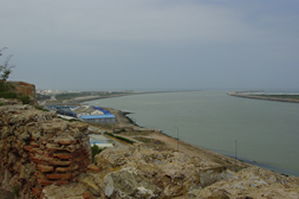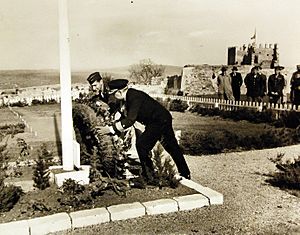Battle of Port Lyautey facts for kids
Quick facts for kids Battle of Port Lyautey |
|||||||
|---|---|---|---|---|---|---|---|
| Part of Operation Torch of World War II | |||||||
 Map of the American landing at Port Lyautey, French defensive and counter-attack positions in red |
|||||||
|
|||||||
| Belligerents | |||||||
| Commanders and leaders | |||||||
| Casualties and losses | |||||||
| 79 killed | Heavy; over 400 casualties | ||||||
The Battle of Port Lyautey was a big fight that happened during World War II. It took place from November 8 to 10, 1942, in a city called Port Lyautey in French Morocco. Today, this city is known as Kenitra.
American soldiers fought against French forces who were controlled by the Vichy regime. After more than two days of intense fighting, the American troops won. They took control of the city and its important airfield. This battle was a key part of a larger plan called Operation Torch.
Contents
Why the Battle Happened
The attack on Port Lyautey was part of a bigger mission called Operation Torch. This was a huge landing by Allied forces. Their goal was to take control of North Africa from German influence.
A special group of American soldiers, called Sub Task Force Goalpost, had three main goals for attacking Port Lyautey:
- Capture the small beach village of Mehdiya.
- Take over the old fortress, called the Kasbah Mahdiyya, which guarded the river mouth.34°15′51″N 006°39′27″W / 34.26417°N 6.65750°W
- Secure the airfield nearby.
Who Was in Charge
The entire Operation Torch was led by U.S. General Dwight D. Eisenhower. The American forces landing in western North Africa were under General George S. Patton. The specific group attacking Port Lyautey, Sub Task Force Goalpost, was led by General Lucian Truscott.
Getting Ready for Battle
Planning the Attack
Before the landings, the U.S. had many officials in French North Africa. They gathered a lot of secret information about Morocco. They also found French people who did not support the Vichy regime or the Axis forces.
Two important people, Karl Victor Clopet and René Malevergne, secretly went to London. Clopet knew a lot about the ports and defenses along the coast. Malevergne knew the Sebou river well. He also shared information about people in Port Lyautey who supported the Germans.
Preparing the Troops
General Truscott and his team planned the attack on Port Lyautey in London. The main goal was to capture and supply the airfield at Port Lyautey. The 9th Infantry Division, especially the 60th Infantry Regiment, was chosen for this mission. They trained at Fort Bragg in North Carolina.
Here's a look at the American forces assigned to attack Port Lyautey:
| Unit | Personnel | Vehicles |
|---|---|---|
| 9th ID 1st BLT, 60th Infantry | 1345 | 118 |
| 9th ID 2nd BLT, 60th Infantry | 1268 | 117 |
| 9th ID 3rd BLT, 60th Infantry | 1461 | 118 |
| Other 60th Infantry Troops | 1318 | 224 |
| 66th Armored Landing Team, 1st Battalion, 66th Armored Regiment | 919 | 163 |
| XII Air Support Command | 1936 | 103 |
| 692nd-697th Coast Artillery (AA) Batteries | 448 | 0 |
| 66th Topographic Engineer Company (Detachment) | 5 | 0 |
| 1st Armored Signal Battalion | 3 | 1 |
| 9th Signal Company | 68 | 10 |
| 122nd Signal Company | 26 | 4 |
| 163rd Signal Company | 6 | 1 |
| 239th Signal Company | 35 | 4 |
| 56th Medical Battalion | 36 | 0 |
| 2nd Broadcasting Station Operation Detachment | 30 | 5 |
| Counterintelligence Group | 16 | 0 |
| Prisoner Interrogation Group | 21 | 0 |
| Civil Government Personnel | 4 | 0 |
| Force Headquarters | 46 | 10 |
| Submarine Markers | 30 | 0 |
| Harbor Obstruction Experts | 40 | 0 |
| Naval Personnel | 18 | 0 |
| Total | 9079 | 881 |
Getting Ships Ready
Not all ships could load at the same time. So, some troops loaded a full week before sailing. The soldiers were well-trained, even doing some practice landings.
On October 14, General Patton held a meeting. They needed a secret password for the attack. Someone suggested "George Patton." So, the challenger would say "George," and a friend would reply "Patton."
On October 15, troops and equipment began loading. The next day, the ships sailed to Solomon's Island in Chesapeake Bay for a final practice.
Practice Landings
At Solomon's Island, they practiced communications and procedures. Everything seemed to go well at first. But a ship captain refused to lower his landing craft. He said his crew wasn't trained enough. General Truscott convinced him that the mission would go on. The captain then agreed to train his crew. The next day, they began their journey to North Africa.
Airfield Support
The Port Lyautey airfield was very important. It had concrete runways and hangars. It was about five miles from the landing beaches. The Sebou River, which led to the airfield, was shallow. Only ships drawing less than 19 feet (5.8 m) could use it.
Planners decided to use an auxiliary aircraft carrier, USS Chenango, to launch planes. They also needed a special ship to deliver aviation fuel and bombs directly to the airfield. They chose the SS Contessa, a cargo ship.
The Contessa was old and leaky. It needed quick repairs. Many of its crew left, expecting a long delay. But with new volunteer sailors, the ship was repaired quickly. It sailed three days late, unescorted, to catch up with the main convoy. The Contessa, carrying 738 tons of fuel and bombs, finally joined the convoy on November 7.
The Battle Begins
November 7: Arrival
The American attack group arrived off Mehdia, Morocco, just before midnight on November 7, 1942. The battleship Texas and light cruiser Savannah took their positions.
The transport ships had lost their formation. This caused delays in getting the landing craft ready. General Truscott decided to push back the landing time by 30 minutes.
President Franklin D. Roosevelt and General Eisenhower had already broadcast messages. The landings in the Mediterranean had already started. So, the element of surprise was lost at Mehdia.
The French defenses at Mehdia were not heavily manned. About 70 men were in the fort. They had some guns on the tableland and on railroad cars. More guns were brought in after the attack started. The French infantry included Moroccan soldiers and native Goums.
November 8: First Landings
At dawn on November 8, two American officers, Col. Demas T. Craw and Maj. Pierpont M. Hamilton, went to Port Lyautey. They carried a diplomatic letter hoping to stop the fighting. As they neared the town, a French machine gunner fired, killing Col. Craw. Major Hamilton was taken to the French commander, Col. Charles Petit. The French commander was sympathetic to the Americans but had no orders to stop fighting. So, the French continued to fight.
American troops from the 60th Infantry Regiment began landing. The first wave of landing boats was delayed. The second wave landed on time, causing confusion. French defenders resisted with small arms and cannon fire from the Kasbah fortress. By the end of the day, the Americans had secured the beach. But they had not yet captured the other important objectives. The night was stormy, and soldiers struggled to find their units in the dark.
November 9: Attacking the Fortress
On the second day, the Americans continued their attacks on the Kasbah fortress. They took control of the ground around the fort. However, the fortress itself was still holding out. The French defenders fought hard and stopped several American attacks. The Americans did not succeed in capturing the fort that day.
November 10: Victory
Finally, on the third day, November 10, the American forces broke through. They captured the Kasbah fortress. This led to the final success of taking the local airfield.
At 4:20 PM, the Contessa entered the Sebou River. It was there to deliver aviation fuel and bombs for the 76 Army P-40 aircraft. These planes had been launched earlier by the carrier Chenango. However, the Contessa ran aground near the Kasbah. It had to wait for a higher tide on November 11.
These American victories led to a truce, or ceasefire, being declared on November 11.
After the Battle
After the battle, most of the American units stayed in the area. In January 1943, President Roosevelt made a surprise visit to the troops. He toured the Kasbah and saw where the soldiers had landed. He also placed a wreath at a small cemetery for American soldiers who died in the battle.
General George Patton later said the Battle of Port Lyautey was very serious. The beach conditions were bad, and many boats were lost. It took more than two days to capture the fort. He noted that the French had fought very bravely.
A cemetery was created near the Kasbah fortress. Here, the soldiers who died in the Battle of Port Lyautey were buried. In January 1943, General Mark Clark also laid a wreath at the cemetery.




